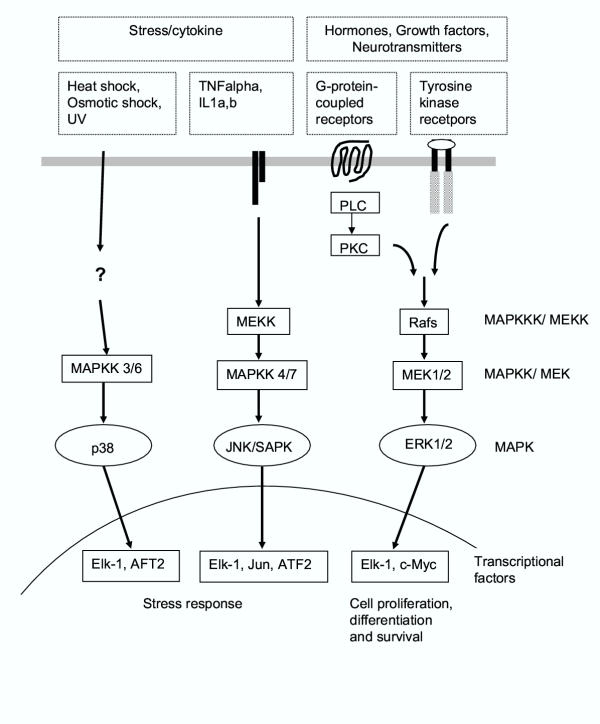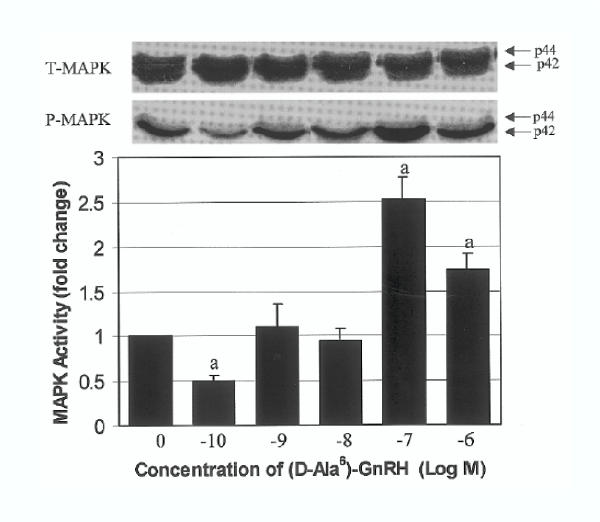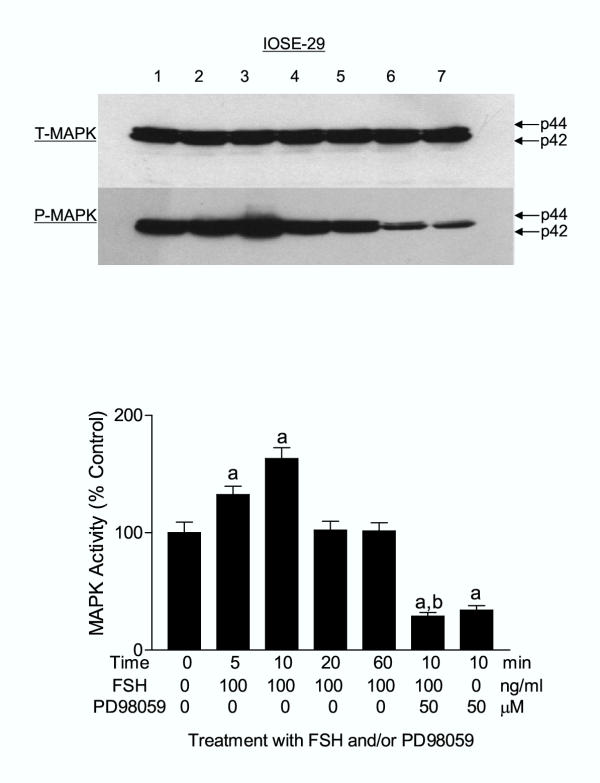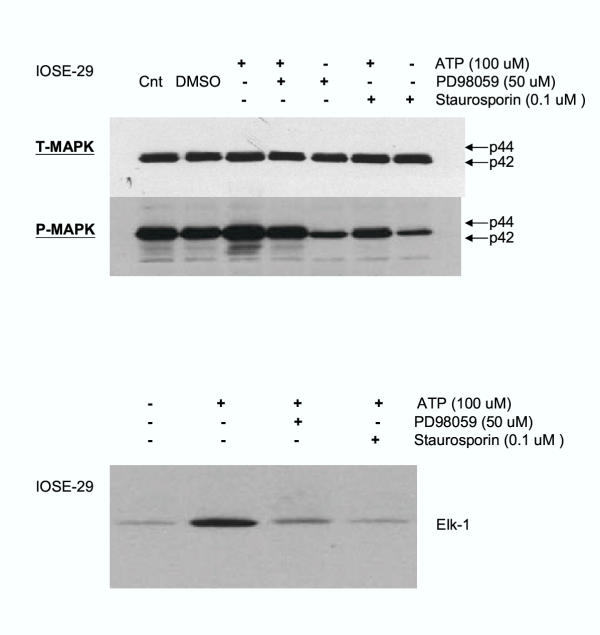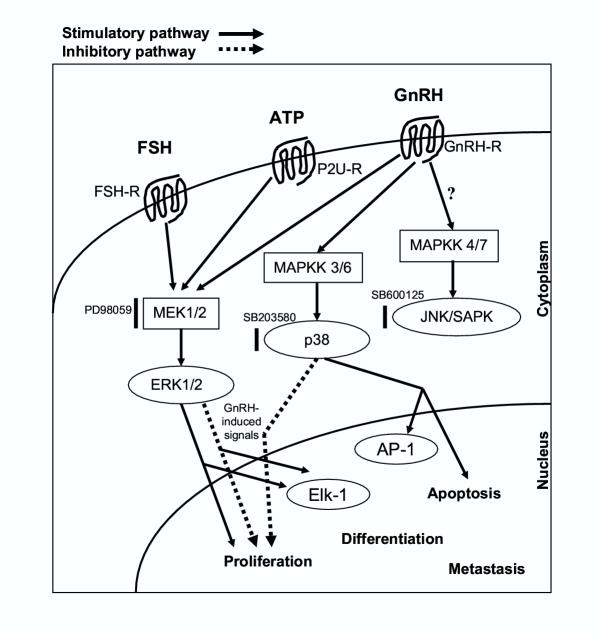Abstract
Mitogen-activated protein kinases (MAPKs) are a group of serine/threonine kinases which are activated in response to a diverse array of extracellular stimuli and mediate signal transduction from the cell surface to the nucleus. It has been demonstrated that MAPKs are activated by external stimuli including chemotherapeutic agents, growth factors and reproductive hormones in ovarian surface epithelial cells. Thus, the MAPK signaling pathway may play an important role in the regulation of proliferation, survival and apoptosis in response to these external stimuli in ovarian cancer. In this article, an activation of the MAPK signaling cascade by several key reproductive hormones and growth factors in epithelial ovarian cancer is reviewed.
Keywords: MAPK, signaling pathway, ovarian cancer
Introduction
Mitogen-activated protein kinases (MAPKs) are a group of serine/threonine kinases which are activated in response to a diverse array of extracellular stimuli, and mediate signal transduction from the cell surface to the nucleus [1]. As illustrated in Fig. 1, three MAPK family including extracellular signal-regulated kinases (ERK1 and ERK2), c-jun terminal kinase/stress-activated protein kinases (JNK/SAPK) and p38, have been well characterized [2-4]. In addition, other MAPK family members, including ERK3, 4 and 5, four p38-like kinases and p57 MAPK have been cloned, but the biological role of these MAPKs is not well understood [2,4]. The MAPK cascade is activated via two distinct classes of cell surface receptors, receptor tyrosine kinases (RTKs) and G protein-coupled receptors (GPCRs). The signals transmitted through this cascade can cause an activation of diverse molecules which regulate cell growth, survival and differentiation. ERK1 (p44 MAPK) and ERK2 (p42 MAPK) activated by mitogenic stimuli are a group of the most extensively studied members, whereas JNK/SAPK and p38 are activated in response to stress such as heat shock, osmotic shock, cytokines, protein synthesis inhibitors, antioxidants, ultra-violet, and DNA-damaging agents [5,6]. MAPK family members are directly regulated by the kinases known as MAPK kinases (MAPKKs), which activate the MAPKs by phosphorylation of tyrosine and threonine residues [2,4,6]. At least seven different MAPKKs have been cloned and characterized [2,4]. The first MAPKKs cloned were MAPK/ERK kinase 1 and 2 (MEK 1/2), which specifically activate ERKs. MKK3 and 6 specifically activate p38, whereas MKK5 stimulates the phosphorylation of ERK5. The MKK4 and 7 are known to activate JNK. The MAPKKs are activated by a rapidly expanding group of kinases called MAPKK kinases (MAPKKKs), which activate the MAPKKs by phosphorylation of serine and threonine residues [4,6]. These include Raf-1, A-Raf, B-raf, MAPK/ERK kinase 1–4 (MEKK1-4), apoptosis-stimulating kinase-1 (ASK-1), and mixed lineage kinse-3 (MLK-3). The MAPKKKs may be activated by kinases known as MAPKKK kinases (MAPKKKKs), one of which is p21-activated kinase (PAK). In addition to these kinases, low molecular weight GTP-binding (LMWG) proteins regulate the activity of MAPKKKs and MAPKKKKs [2,4]. There are several different families of LMWG proteins, two of which include the Ras (N-Ras, K-Ras, and H-Ras) and Rho (Rac 1, 2 and 3, Cdc42 and Rho A, B and C) families. The activated MAPKs phosphorylate a large number of both cytoplasmic and nuclear proteins, exerting their specific functions. For example, activated ERK1/2 phosphorylate ternary complex factor (TCF) proteins such as Elk-1 and SAP-1, which form transcriptional complexes with serum response factor (SRF) in the promoter region of early response genes (e.g. c-fos, egr-1, junB) and thereby regulate their expression [7]. As shown in Fig. 1, many of these nuclear proteins, as a result of their ability to modulate expression of other proteins, are potential candidates for critical factors involved in the cellular response to stimuli.
Figure 1.
The MAPK signaling transduction pathways.
It appears that the majority of ovarian tumors arise from the ovarian surface epithelium (OSE), which is a simple squamous-to-cuboidal mesothelium covering the ovary [8]. As mentioned earlier, the MAPK cascade can be activated via both RTKs and GPCRs, which include the receptors of growth factors, gonadotropins and gonadotropin-releasing hormones (GnRH). In ovarian cancer cells, MAPKs are activated and regulated by cisplatin [9], paclitaxel [10], endothelin-1 [11] and GnRH [12] suggesting that the MAPK signaling pathway plays an important role in the regulation of proliferation, survival and apoptosis in response to these external stimuli in ovarian cancer. In this review, we summarize the activation of the MAPK and its signaling cascade induced by hormones, growth factors and chemotherapeutic agents in normal and (pre)neoplastic OSE cells.
Activation of MAPK by hormonal factors
There is increasing evidence that gonadotropin-releasing hormone (GnRH) and its agonists (GnRHa) may play a critical role in the inhibition of cell proliferation in gynecological cancers including ovarian and endometrial cancers. However, their biological mechanism remains to be uncovered. The GnRH receptor (GnRH-R) belongs to the family of GPCRs. MAPK has been implicated in the antiproliferative effect of GnRHa in CaOV-3 ovarian cancer cell line [12]. Treatment of CaOV-3 cells with GnRHa resulted in an activation of ERK at 5 min, reached the highest activation at 3 h and sustained until 24 h, whereas GnRHa had no effect on the activation of the JNK. In addition, the ERK kinase was also activated and an increase in phosphorylation of son of sevenless (Sos), and Shc was observed following GnRHa treatment. Treatment with an inhibitor of mitogen-activated protein/ERK kinase, PD98059 reversed the antiproliferative effect of GnRHa and the GnRH-induced dephosphorylation of the retinoblastoma protein. These results indicate that an activation of ERK may play a role in the antiproliferative effect of GnRHa [12]. In our laboratory, we have shown that an agonist of GnRH (D-Ala6)-GnRH, induced a biphasic pattern of ERK-1/-2 activation in OVCAR-3 cells (Fig. 2). A low concentration of GnRHa (10-10 M) resulted in a significant decrease of MAPK activity, whereas high concentrations (10-7 and 10-6 M) induced an activation of MAPK pathway in ovarian and placental cells [13]. It is of interest to note that GnRH signaling appears to involve ERK-1/-2 phosphorylation through the activation of adenylyl cyclase and PKC in rat luteinized ovarian tumors [14].
Figure 2.
The effect of GnRH on ERK-1/-2 (p44/p42) activation in ovarian cancer line. The phosphorylated form (P-MAPK) normalized by total form (T-MAPK) was analyzed in a dose-dependent manner by immunoblot analysis in OVCAR-3 cells treated with GnRH. Values are represented as the mean ± SD of three individual experiments. a, P < 0.05 versus untreated control. [Reproduced, permission with, from: Kang SK, Tai CJ, Cheng KW, Leung PC; "Gonadotropin-releasing hormone activates mitogen-activated protein kinase in human ovarian and placental cells" in: Mol Cell Endocrinol 2000, 170:143–151. Copyright from Elsevier]
An involvement of gonadotropins, follicle-stimulating hormone (FSH) and luteinizing hormone (LH), has been proposed in the progression and metastasis of ovarian cancer. Expression of FSH receptor (FSH-R), a member of the GPCRs family, has been demonstrated in normal OSE [15], ovarian inclusions and epithelial tumors [16], implicating a potential role of FSH in these cells. Treatment with FSH resulted in a growth-stimulation in ovarian cancer cells in a dose- and time-dependent manner in vitro [16,17]. Despite these findings, the precise molecular mechanism of FSH in terms of growth stimulation and intracellular signaling in ovarian cancer remained unknown. In a recent study, we have investigated the involvement of MAPKs in the mechanism of the growth-stimulatory effect of FSH in pre-neoplastic OSE cells [18]. Treatment with FSH (10, 100 and 1,000 ng/ml) resulted in the MAPK activation of immortalized OSE (IOSE-29) cells as shown in Fig. 3. The stimulatory effect of FSH in the cellular proliferation and MAPK activation was completely abolished in the presence of PD98059, a MEK inhibitor (Fig. 3). In IOSE-29 cells, treatment with FSH significantly increased MAPK activity at 5–10 min, and an activated MAPK declined to control level after 20 min in these cells (Fig. 4). In addition, treatment with FSH resulted in substantial phosphorylation of Elk-1, the Ets family transcriptional factor [18]. These results support the hypothesis that the MAPK cascade is involved in cellular function such as growth stimulation in response to FSH in pre-neoplastic OSE cells.
Figure 3.
Effect of FSH in the presence or absence of PD98059 on ERK-1/-2 (p44/p42) activation. The P-MAPK normalized by T-MAPK was analyzed in a dose-dependent manner by immunoblot analysis in IOSE-29 cells treated with FSH. Data are shown as the means of three individual experiments, and are presented as the mean ± SD. a, P < 0.05 vs. untreated control; b, P < 0.05 vs. FSH (100 ng/ml) treatment; c, P < 0.05 vs. PD98059 (50 μM) treatment. 1, untreated control; 2, FSH (10 ng/ml) treatment; 3, FSH (100 ng/ml) treatment; 4, FSH (1000 ng/ml) treatment; 5, FSH (100 ng/ml) treatment; 6, FSH (100 ng/ml) plus PD98059 (50 μM) treatment; 7, PD98059 (50 μM) treatment. [Reproduced, permission with, from: Choi KC, Kang SK, Tai CJ, Auersperg N, Leung PC; "Follicle-stimulating hormone activates mitogen-activated protein kinase in preneoplastic and neoplastic ovarian surface epithelial cells" in: J Clin Endocrinol Metab 2002, 87:2245–2253. Copyright from Endocrine Society]
Figure 4.
Effect of FSH in the presence or absence of PD98059 on ERK-1/-2 (p44/p42) activation. The P-MAPK normalized by T-MAPK was analyzed in a time-dependent manner by immunoblot analysis in IOSE-29 cells treated with FSH. Data are shown as the means of three individual experiments, and are presented as the mean ± SD. a, P < 0.05 vs. untreated control; b, P < 0.05 vs. FSH (100 ng/ml) treatment for 10 min. 1, untreated control; 2, FSH (100 ng/ml) treatment for 5 min; 3, FSH (100 ng/ml) treatment for 10 min; 4, FSH (100 ng/ml) treatment for 20 min; 5, FSH (100 ng/ml) treatment for 60 min; 6, FSH (100 ng/ml) plus PD98059 (50 μM) treatment for 10 min; 7, PD98059 (50 μM) treatment. [Reproduced, permission with, from: Choi KC, Kang SK, Tai CJ, Auersperg N, Leung PC; "Follicle-stimulating hormone activates mitogen-activated protein kinase in preneoplastic and neoplastic ovarian surface epithelial cells" in: J Clin Endocrinol Metab 2002, 87:2245–2253. Copyright from Endocrine Society]
Similar to FSH, adenosine triphosphate (ATP) has been implicated in the regulation of cell proliferation and activation of MAPK pathway in ovarian cancer cells. ATP binds to heterotrimeric G protein-coupled P2 purinoceptors and extracellular ATP has been suggested to play a role in cellular proliferation and intracellular calcium concentrations (Ca2+) in ovarian cancer cells [19,20]. Our recent results indicated that treatment with ATP resulted in an activation of ERK-1/-2 in IOSE-29 cell line as seen Fig. 5[21]. The stimulatory effect of ATP in the cellular proliferation and MAPK activation was completely abolished in the presence of PD98059 and staurosporin (a PKC inhibitor), suggesting that the growth stimulatory effect of ATP is mediated via PKC-dependent MAPK activation in pre-neoplastic OSE cells (Fig. 5). Treatment with ATP resulted in substantial phosphorylation of Elk-1, further implicating the MAPK cascade in the growth stimulatory effect of ATP in pre-neoplastic OSE cells [21].
Figure 5.
Effect of ATP on ERK-1/-2 (p44/p42) and Elk-1 in the absence or presence of PD98059 and staurosporin. To examine the role of ATP on MAPKs in IOSE-29, the cells were pretreated with 50 μM PD98059 or 0.1 μM staurosporin for 30 min, followed by treatment with 100 μM ATP for 10 min. The P-MAPK normalized by T-MAPK was analyzed by immunoblot analysis, and Elk-1, a downstream pathway of ERK-1/-2, was measured by in vitro MAPK assay, respectively. [Reproduced, permission with, from: Choi K-C, Tai C-J, Tzeng C-R, Auersperg N, Leung PC; "Adenosine triphosphate (ATP) activates mitogen-activated protein kinases (MAPKs) in neoplastic ovarian surface epithelium (OSE) cells" in: Biol Reprod 2003, 68: 309–315. Copyright from Society for the Study of Reproduction]
Activation of MAPK by growth factors and cytokines
Endothelin-1 (ET-1) is a potential autocrine regulatory factor in ovarian cancer. Treatment of OVCA 433 ovarian cancer with ET-1 resulted in a phosphorylation of ERK-2 and mitogenic responses. The epidermal growth factor receptor (EGF-R)/ras-dependent pathway may contribute to the activation of MAPK/ERK-2 and mitogenic signaling induced by ET-1 in these cells, suggesting that ET-1 induced activation of MAPK is mediated in part by signaling pathways that are initiated by transactivation of the EGF-R [11]. As autocrine regulators, lysophosphatidic acid (LPA) and sphingosine-1-phosphate (S1P) have been demonstrated to activate MAPK kinase (MEK) and p38 MAPK via AKT pathway in HEY ovarian cancer cells. The kinase activity and S473 phosphorylation of Akt induced by LPA and S1P required both MEK and p38 MAPK, and MEK is likely to be upstream of p38 in these cells, suggesting that the requirement for both MEK and p38 is cell type- and stimulus-specific [22]. In rhesus ovarian surface epithelial cells in culture, treatment with extracellular calcium induced an activation of MAPK in the response to cell proliferation in these normal cells [23]. Human interleukin-8 (IL-8) rapidly activated ERK-1/-2 pathway via stimulation of the CXCR-1/2 receptors [24]. By using inhibitors such as genestein and herbimycin A, tyrosine kinases have been shown to be involved in the IL-8 activation of ERK-1/-2 in SKOV-3 cells, suggesting an important cross-talk between the chemokine and growth factor pathways in the migration and proliferation in ovarian cancer cells [24].
In addition to ERK1/2, the JNK pathway has been suggested to play a role in the cell proliferation and apoptosis in ovarian cancer. For instance, treatment with tumor necrosis factor (TNF) alpha activated ERK1/2 at 10–20 min, and a maximum threefold induction of ERK1/2 activity was observed after 1 min of treatment [25]. Inhibition of TNF alpha-induced ERK1/2 activity by PD98059 was associated with induction of apoptosis in the TNF alpha-resistant cell line UCI 101. Inhibition of TNF alpha-induced ERK1/2 activity was accompanied by a subsequent transient increase in TNF alpha-induced JNK1 activity. These results indicate that ERK1/2 activity may modulate cellular response to TNF alpha. A balance between ERK1/2 and JNK1 activation may be pivotal in the cellular growth and apoptosis response to TNF alpha [25].
Activation of MAPK by chemotherapeutic agents
Cisplatin has been widely used as a chemotherapeutic agent to treat ovarian cancers, although its use is somewhat limited because of cisplatin-resistance. The molecular mechanism of cisplatin-induced biological effect in ovarian cancer is not well understood. Cisplatin caused a late and prolonged induction of both ERK1/2 and JNK1 activity in a dose-dependent manner, whereas no significant difference was observed in p38 activity in SKOV-3 cells [9]. These results suggest that ERK and other signal transduction pathways may play a role in response to cisplatin and be important for the development of new strategies to enhance the therapeutic use of platinum drugs. In cisplatin-resistant CaOV-3 and cisplatin-sensitive A2780 ovarian cancer cells, cisplatin induced an activation of both ERK and JNK in distinct time and dose patterns [26]. Cisplatin-induced JNK activation was neither extracellular and intracellular Ca2+-dependent nor protein kinase C-dependent, whereas cisplatin-induced ERK activation was extracellular and intracellular Ca2+-dependent and protein kinase C-dependent [26]. In regard to the regulation of apoptosis by cisplatin, it has been shown that cisplatin activated a robust apoptotic pathway involved in the activation of JNK and p38 MAPK in cisplatin-sensitive ovarian cancer cells, whereas it fails to elicit the response in cisplatin-resistant 2008/C13 cells [27]. In cisplatin-resistant cells, the proteolytic activation of MEKK1 by caspase-3 is deficient, suggesting that inadequate caspase-3 processing and MEKK1 activation may induce a cisplatin-resistant phenotype [27].
The activation of two MAP kinases, JNK1 and ERK1/2 was compared in the cisplatin-sensitive ovarian carcinoma cell line A2780 and the cisplatin-resistant cell lines CP70 and C200 [28]. Distinct patterns of cisplatin-induced JNK1 and ERK1/2 activation were observed in the cell lines with different levels of cisplatin sensitivity, and inhibition of cisplatin-induced ERK1/2 activation appeared to enhance sensitivity to cisplatin in both cisplatin-sensitive and cisplatin-resistant cell lines. It appears that these MAPK pathways may be important in the cisplatin-resistance in ovarian cancer, which can be used as a potential therapeutic strategy [28]. More recent data indicate that cisplatin differentially induced JNK and p38 pathways, with the cisplatin-sensitive cells showing prolonged (8–12 h) activation and the cisplatin-resistant cells showing only transient (1–3 h) activation of JNK and p38 [29]. In addition, the inhibition of cisplatin-induced JNK and p38 activation blocked cisplatin-induced apoptosis and persistent activation of JNK resulted in an increase in the phosphorylation of c-Jun transcription factor, which stimulated a transcription of an immediate downstream target, a death inducer Fas ligand (FasL) in cisplatin-sensitive cells. Thus, it appears that the JNK-c-Jun-FasL-Fas signaling pathway plays an important role in the regulation of cisplatin-induced apoptosis in ovarian cancer cells, and the duration of JNK activation may be essential in the determination of survival or apoptosis in ovarian cancer cells [29].
Taxol, a microtubule stabilizer, is a useful therapeutic agent for ovarian cancer treatment. Treatment with taxol resulted in an activation of ERK1/2 and p38 MAPK in human ovarian carcinoma cells with distinct kinetics [30]. The low concentrations of taxol (1–100 nM) activated ERK1/2 within 0.5–6 h, whereas a longer exposure (24 h) at low concentrations abrogated ERK1/2 phosphorylation/activation. Higher concentrations (1–10 μM) of taxol resulted in a sharp inhibition of ERK1/2 activity, whereas same concentrations activated p38 kinase at 2 – 24 h, indicating that the activation of MAPK may be dependent on the dose and exposure time of chemotherapeutic agent [30]. Interestingly, treatment with paclitaxel resulted in a phosphorylation of p70S6K (T421/S424) and this paclitaxel-induced phosphorylation requires both de novo RNA and protein synthesis via multiple signaling pathways including ERK1/2 MAP kinase, JNK, PKC, Ca(++), PI3K, and mammalian target of rapamycin (mTOR). Thus, paclitaxel is able to induce p70S6K phosphorylation and exert its antitumor effect via multiple signaling pathways, especially inhibition of p70S6K [31].
Genes related with the activation of MAPK
The expression levels of kinases have compared in normal, immortalized and neoplastic OSE cells [32]. The expression levels of casein kinase II (CK2), p38 MAPK, cyclin-dependent kinase, and the phosphatidylinositol 3-kinase (PI3K) effectors Akt2 and p70 S6 kinase (S6K) were several-fold higher in neoplastic OSE than in normal OSE, whereas no significant difference was observed in the expression of ERK1/2 [32]. Interestingly, c-Jun NH2-kinase but not PI3-K resulted in telomerase activity. An inhibition of JNK by a specific inhibitor reversed telomerase activity, while the expression of JNK induced an activation of a reporter gene fused to the hTERT promoter sequence at transcriptional level, indicating that JNK plays a critical role in the regulation of telomerase activity and may provide possible therapeutic approaches to ovarian cancer [33]. In addition, the correlation between BRCA1 and stress-associated MAPK has been proposed in ovarian cancer cells [34]. The JNK, an apoptotic signaling pathway, was induced by overexpression of BRCA1, and BRCA1 enhanced the signaling pathways that sequentially involved H-Ras, MEKK4, JNK, Fas ligand/Fas interactions, and caspase-9 activation [34].
Recently, it has been shown that gamma-synuclein is dramatically up-regulated in the vast majority of late-stage breast and ovarian cancers and its overexpression may be related with enhanced tumorigenicity. Furthermore, overexpression of gamma-synuclein resulted in a constitutive activation of ERK1/2 and down-regulation of JNK1 in response to environmental stress signals, including UV, arsenate and heat shock [35]. The cross-talk between the MAPK signaling pathway and multi-drug resistant protein MDR-1 has been suggested in terms of sensitivity or resistance to chemotherapy. A constitutive activation of the ERK1/2 pathway was observed, whereas the level of active JNK and p38 remained unchanged in the taxol resistant cells. Inhibition of the ERK1/2 pathway by specific inhibitors, UO126 or PD098059, resulted in a re-sensitization in the taxol resistant cells [36].
There is some evidence that the MAPK pathway may play a role in the metastasis of ovarian cancer. Treatment of ovarian cancer cells with MEK1 inhibitors, U0126 and PD98059, induced a significant suppression of the MMP-9 secretion activated by fibronectin (FN), suggesting an importance of these signaling molecules as a chemotherapeutic target for cancer to prevent metastasis [37]. The urokinase-type plasminogen activator receptor (u-PAR) has been implicated in tumor progression, and the expression of this gene is strongly up-regulated by phorbol 12-myristate 13-acetate (PMA), a PKC activator. Treatment of the u-PAR-deficient ovarian cancer OVCAR-3 cells, which contain low JNK activities, with PMA resulted in a rapid (5 min) activation of JNK pathway. This finding suggests that the PMA- or c-Ha-Ras-dependent stimulation of u-PAR gene expression requires a JNK1-dependent signaling module [38].
Concluding Remarks
There is increasing evidence that the three well-characterized members of the MAPK family, ERK1/2, JNK/SAPK and p38, play an important role in the regulation of proliferation, survival and apoptosis in ovarian cancer in response to the external stimuli including hormones, growth factors, cytokines and chemotherapeutic chemicals. The signaling pathways by which hormones such as FSH, ATP and GnRH exert their effects in the regulation of cell proliferation and apoptosis in ovarian cancer cells are proposed in Fig. 6. As well, MAPK pathways may contribute to the metastasis and chemoresistance of ovarian cancer. A better understanding of the MAPK and other signaling pathways in normal and neoplastic OSE will provide new insights for the development of novel therapeutic approach to ovarian cancer.
Figure 6.
Activation of the MAPK signaling pathway by FSH, ATP and GnRH in ovarian cancer.
Acknowledgments
Acknowledgments
PCKL is the recipient of a Distinguished Scholar Award from the Michael Smith Foundation for Health Research. This work was supported by the Canadian Institutes of Health Research.
Contributor Information
Kyung-Chul Choi, Email: kchoi@cw.bc.ca.
Nelly Auersperg, Email: auersper@interchange.ubc.ca.
Peter CK Leung, Email: peleung@interchange.ubc.ca.
References
- Davis RJ. MAPKs: new JNK expands the group. Trends Biochem Sci. 1994;19:470–473. doi: 10.1016/0968-0004(94)90132-5. [DOI] [PubMed] [Google Scholar]
- Johnson GL, Lapadat R. Mitogen-activated protein kinase pathways mediated by ERK, JNK, and p38 protein kinases. Science. 2002:1911–1912. doi: 10.1126/science.1072682. [DOI] [PubMed] [Google Scholar]
- Cobb MH, Goldsmith EJ. How MAP kinases are regulated. J Biol Chem. 1995;270:14843–14846. doi: 10.1074/jbc.270.25.14843. [DOI] [PubMed] [Google Scholar]
- Fanger GR. Regulation of the MAPK family members: Role of subcellular localization and architectural organization. Histol Histopathol. 1999;14:887–894. doi: 10.14670/HH-14.887. [DOI] [PubMed] [Google Scholar]
- Garrington T, Johnson GL. Organization and regulation of mitogen-activated protein kinase signaling pathway. Curr Opin Cell Biol. 1999;11:211–218. doi: 10.1016/S0955-0674(99)80028-3. [DOI] [PubMed] [Google Scholar]
- Robinson MJ, Cobb MH. Mitogen-activated protein kinase pathways. Curr Opin Cell Biol. 1997;9:180–186. doi: 10.1016/S0955-0674(97)80061-0. [DOI] [PubMed] [Google Scholar]
- Wasylyk B, Hagman J, Gutierrez-Hartmann A. Ets transcription factors: nuclear effectors of the Ras-MAP kinase signaling pathway. Trends Biol Sci. 1998;23:213–216. doi: 10.1016/S0968-0004(98)01211-0. [DOI] [PubMed] [Google Scholar]
- Auersperg N, Maines-Bandiera SL, Kruk PA. Human ovarian surface epithelium: growth patterns and differentiation. In: Sharp F, Mason P, Blacket T, Berek J, editor. Ovarian Cancer 3. Champman & Hall, London; 1995. pp. 157–169. [Google Scholar]
- Persons DL, Yazlovitskaya EM, Cui W, Pelling JC. Cisplatin-induced activation of mitogen-activated protein kinases in ovarian carcinoma cells: inhibition of extracellular signal-regulated kinase activity increases sensitivity to cisplatin. Clin Cancer Res. 1999;5:1007–1014. [PubMed] [Google Scholar]
- Wang TH, Popp DM, Wang HS, Saitoh M, Mural JG, Henley DC, Ichijo H, Wimalasena J. Microtubule dysfunction induced by paclitaxel initiates apoptosis through both c-Jun N-terminal kinase (JNK)-dependent and -independent pathways in ovarian cancer cells. J Biol Chem. 1999;274:8208–8216. doi: 10.1074/jbc.274.12.8208. [DOI] [PubMed] [Google Scholar]
- Vecca F, Bagnato A, Catt KJ, Tecce R. Transactivation of the epidermal growth factor receptor in endothelin-1 induced mitogenic signaling in human ovarian carcinoma cells. Cancer Res. 2000;60:5310–5317. [PubMed] [Google Scholar]
- Kimura A, Ohmichi M, Kurachi H, Ikegami H, Hayakawa J, Tasaka K, Kanda Y, Nishio Y, Jikihara H, Matsuura N, Murata Y. Role of mitogen-activated protein kinase/extracellular signal-regulated kinase cascade in gonadotropin-releasing hormone-induced growth inhibition of a human ovarian cancer cell line. Cancer Res. 1999;59:5133–5142. [PubMed] [Google Scholar]
- Kang SK, Tai CJ, Cheng KW, Leung PC. Gonadotropin-releasing hormone activates mitogen-activated protein kinase in human ovarian and placental cells. Mol Cell Endocrinol. 2000;170:143–151. doi: 10.1016/S0303-7207(00)00320-8. [DOI] [PubMed] [Google Scholar]
- Chamson-Reig A, Sorianello EM, Catalano PN, Fernandez MA, Pignataro OP, Libertun C, Lux-Lantos VA. Gonadotropin-releasing hormone signaling pathways in an experimental ovarian tumor. Endocrinology. 2003;144:2957–2966. doi: 10.1210/en.2003-0011. [DOI] [PubMed] [Google Scholar]
- Zheng W, Magid MS, Kramer EE, Chen YT. Follicle-stimulating hormone receptor is expressed in human ovarian surface epithelium and fallopian tube. Am J Pathol. 1996;148:47–53. [PMC free article] [PubMed] [Google Scholar]
- Zheng W, Lu JJ, Luo F, Zheng Y, Feng YJ, Felix JC, Lauchlan SC, Pike MC. Ovarian epithelial tumor growth promotion by follicle-stimulating hormone and inhibition of the effect by luteinizing hormone. Gynecol Oncol. 2000;76:80–88. doi: 10.1006/gyno.1999.5628. [DOI] [PubMed] [Google Scholar]
- Wimalasena J, Dostal R, Meehan D. Gonadotropins, estradiol, and growth factors regulate epithelial ovarian cancer cell growth. Gynecol Oncol. 1992;46:345–350. doi: 10.1016/0090-8258(92)90230-g. [DOI] [PubMed] [Google Scholar]
- Choi KC, Kang SK, Tai CJ, Auersperg N, Leung PC. Follicle-stimulating hormone activates mitogen-activated protein kinase in preneoplastic and neoplastic ovarian surface epithelial cells. J Clin Endocrinol Metab. 2002;87:2245–2253. doi: 10.1210/jc.87.5.2245. [DOI] [PubMed] [Google Scholar]
- Batra S, Fadeel I. Release of intracellular calcium and stimulation of cell growth by ATP and histamine in human ovarian cancer cells (SKOV-3) Can Lett. 1994;77:57–63. doi: 10.1016/0304-3835(94)90348-4. [DOI] [PubMed] [Google Scholar]
- Schultze-Mosgau A, Katzur A, Arora KK, Stojilkovic SS, Diedrich K, Ortmann O. Characterization of calcium-mobilizing P2Y2 receptors in human ovarian cancer cells. Mol Hum Reprod. 2000;6:435–442. doi: 10.1093/molehr/6.5.435. [DOI] [PubMed] [Google Scholar]
- Choi K-C, Tai C-J, Tzeng C-R, Auersperg N, Leung PCK. Adenosine triphosphate (ATP) activates mitogen-activated protein kinases (MAPKs) in neoplastic ovarian surface epithelium (OSE) cells. Biol Reprod. 2003;68:309–315. doi: 10.1095/biolreprod.102.006551. [DOI] [PubMed] [Google Scholar]
- Baudhuin LM, Cristina KL, Lu J, Xu Y. Akt activation induced by lysophosphatidic acid and sphingosine-1-phosphate requires both mitogen-activated protein kinase kinase and p38 mitogen-activated protein kinase and is cell-line specific. Mol Pharmacol. 2002;62:660–671. doi: 10.1124/mol.62.3.660. [DOI] [PubMed] [Google Scholar]
- Wright JW, Toth-Fejel S, Stouffer RL, Rodland KD. Proliferation of rhesus ovarian surface epithelial cells in culture: lack of mitogenic response to steroid or gonadotropic hormones. Endocrinology. 2002;143:2198–2207. doi: 10.1210/en.143.6.2198. [DOI] [PubMed] [Google Scholar]
- Venkatakrishnan G, Salgia R, Groopman JE. Chemokine receptors CXCR-1/2 activate mitogen-activated protein kinase via the epidermal growth factor receptor in ovarian cancer cells. J Biol Chem. 2000;275:6868–6875. doi: 10.1074/jbc.275.10.6868. [DOI] [PubMed] [Google Scholar]
- Yazlovitskaya EM, Pelling JC, Persons DL. Association of apoptosis with the inhibition of extracellular signal-regulated protein kinase activity in the tumor necrosis factor alpha-resistant ovarian carcinoma cell line UCI 101. Mol Carcinog. 1999;25:14–20. doi: 10.1002/(SICI)1098-2744(199905)25:1<14::AID-MC2>3.3.CO;2-M. [DOI] [PubMed] [Google Scholar]
- Hayakawa J, Ohmichi M, Kurachi H, Ikegami H, Kimura A, Matsuoka T, Jikihara H, Mercola D, Murata Y. Inhibition of extracellular signal-regulated protein kinase or c-Jun N-terminal protein kinase cascade, differentially activated by cisplatin, sensitizes human ovarian cancer cell line. J Biol Chem. 1999;274:31648–31654. doi: 10.1074/jbc.274.44.31648. [DOI] [PubMed] [Google Scholar]
- Gebauer G, Mirakhur B, Nguyen Q, Shore SK, Simpkins H, Dhanasekaran N. Cisplatin-resistance involves the defective processing of MEKK1 in human ovarian adenocarcinoma 2008/C13 cells. Int J Oncol. 2000;16:321–325. doi: 10.3892/ijo.16.2.321. [DOI] [PubMed] [Google Scholar]
- Cui W, Yazlovitskaya EM, Mayo MS, Pelling JC, Persons DL. Cisplatin-induced response of c-jun N-terminal kinase 1 and extracellular signal-regulated protein kinases 1 and 2 in a series of cisplatin-resistant ovarian carcinoma cell lines. Mol Carcinog. 2000;29:219–228. doi: 10.1002/1098-2744(200012)29:4<219::AID-MC1004>3.3.CO;2-4. [DOI] [PubMed] [Google Scholar]
- Mansouri A, Ridgway LD, Korapati AL, Zhang Q, Tian L, Wang Y, Siddik ZH, Mills GB, Claret FX. Sustained activation of JNK-p38 MAP kinase pathways in response to cisplatin leads to Fas ligand induction and cell death in ovarian carcinoma cells. J Biol Chem. 2003. [DOI] [PubMed]
- Seidman R, Gitelman I, Sagi O, Horwitz SB, Wolfson M. The role of ERK 1/2 and p38 MAP-kinase pathways in taxol-induced apoptosis in human ovarian carcinoma cells. Exp Cell Res. 2001;268:84–92. doi: 10.1006/excr.2001.5262. [DOI] [PubMed] [Google Scholar]
- Le XF, Hittelman WN, Liu J, McWatters A, Li C, Mills GB, Bast RC., Jr Paclitaxel induces inactivation of p70 S6 kinase and phosphorylation of Thr421 and Ser424 via multiple signaling pathways in mitosis. Oncogene. 2003;22:484–497. doi: 10.1038/sj.onc.1206175. [DOI] [PubMed] [Google Scholar]
- Wong AS, Kim SO, Leung PC, Auersperg N, Pelech SL. Profiling of protein kinases in the neoplastic transformation of human ovarian surface epithelium. Gynecol Oncol. 2001;82:305–311. doi: 10.1006/gyno.2001.6280. [DOI] [PubMed] [Google Scholar]
- Alfonso-De Matte MY, Yang H, Evans MS, Cheng JQ, Kruk PA. Telomerase is regulated by c-Jun NH2-terminal kinase in ovarian surface epithelial cells. Cancer Res. 2002;62:4575–4578. [PubMed] [Google Scholar]
- Thangaraju M, Kaufmann SH, Couch FJ. BRCA1 facilitates stress-induced apoptosis in breast and ovarian cancer cell lines. J Biol Chem. 2000;275:33487–33496. doi: 10.1074/jbc.M005824200. [DOI] [PubMed] [Google Scholar]
- Pan ZZ, Bruening W, Giasson BI, Lee VM, Godwin AK. Gamma-synuclein promotes cancer cell survival and inhibits stress- and chemotherapy drug-induced apoptosis by modulating MAPK pathways. J Biol Chem. 2002;277:35050–35060. doi: 10.1074/jbc.M201650200. [DOI] [PubMed] [Google Scholar]
- Ding S, Chamberlain M, McLaren A, Goh L, Duncan I, Wolf CR. Cross-talk between signalling pathways and the multidrug resistant protein MDR-1. Br J Cancer. 2001;85:1175–1184. doi: 10.1054/bjoc.2001.2044. [DOI] [PMC free article] [PubMed] [Google Scholar]
- Thant AA, Nawa A, Kikkawa F, Ichigotani Y, Zhang Y, Sein TT, Amin AR, Hamaguchi M. Fibronectin activates matrix metalloproteinase-9 secretion via the MEK1-MAPK and the PI3K-Akt pathways in ovarian cancer cells. Clin Exp Metastasis. 2000;18:423–428. doi: 10.1023/A:1010921730952. [DOI] [PubMed] [Google Scholar]
- Gum R, Juarez J, Allgayer H, Mazar A, Wang Y, Boyd D. Stimulation of urokinase-type plasminogen activator receptor expression by PMA requires JNK1-dependent and -independent signaling modules. Oncogene. 1998;17:213–225. doi: 10.1038/sj.onc.1201917. [DOI] [PubMed] [Google Scholar]



